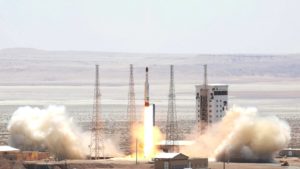
As Iran makes preparation to launch three satellites using Iranian launch vehicles, the United States has warned Tehran not to conduct the launches and condemned the Iranian space programme as a deceptive measure that in reality is designed to help build long-range ballistic missiles.
U.S. Secretary of State Mike Pompeo said on 3 January 2019 in a statement prior to flying to the Middle East that, “The United States will not stand by and watch the Iranian regime’s destructive policies place international stability and security at risk. We advise the regime to reconsider these provocative launches and cease all activities related to ballistic missiles in order to avoid deeper economic and diplomatic isolation.”
Secretary Pompeo cited UN Security Council Resolution 2231 that calls on Iran to cease all ballistic missile testing, even though President Donald J. Trump has withdrawn the United States from the Joint Comprehensive Plan of Action (JCPOA – also known as the Iranian nuclear deal) that underpins that resolution.
After the statement was made by the U.S. Secretary of State, the Iranian foreign minister, Javad Zarif, shot back in a Tweet, stating that Iran is “NOT in violation of Res 2231.” Iran argues that it has a legitimate space programme that manufactures its own satellites as well as launchers, and that the latter are exempt from the provisions of the UNSC resolution 2231.
This claim is backed up by a number of international experts on ballistic missiles and satellite launch vehicles who argue that if Iran was indeed intent on developing long-range ballistic missiles then its designated satellite launch vehicles would not be the ideal technologies to do so.
For example, in a report published last year by the International Institute for Strategic Studies (IISS), missile experts Michael Elleman and Mark Fitzpatrick asserted that, “Iran’s two space-launch rockets, the Safir and Simorgh, are optimized for launching satellites, and are not well suited to perform as a ballistic missile, for which they have never been tested. The second-stage propulsion systems for both rockets rely on low-thrust, long-action time engines, which are ideal for accelerating a satellite on a path parallel to the earth’s surface and into a sustainable orbit. But such engines are poorly suited for ballistic missile trajectories, which reach higher altitudes. Plus, the large and cumbersome Simorgh, which is prepared for launch over an extended time on a fixed launching pad, would be vulnerable to pre-launch attack.”
Critics of Iran’s missile and space programmes argue, however, that Iran has not launched any satellites over the past years despite claiming that they are ready to be launched, but it has carried on its development and testing of ballistic missiles in defiance of UNSC Resolution 2231.
For over 18 months senior Iranian space officials have claimed that four Iranian-built satellites are ready to be imminently launched, yet have not mentioned any particular launch date or by whom the satellites will be placed into orbit. It would appear that Iranian authorities have opted for launches on indigenous satellite launch vehicles.
The four satellites include Payam-e Amirkabir-1, Dousti, and Nahid-1. “Payam-e Amirkabir will be placed into the orbit 500 kilometers above the earth’s surface and its data will be used for developing programs,” Morteza Barari, the head of the Iranian Space Agency (ISA) said last year when describing the three satellites built by Iranian engineers.
Nahid-1 is the first Iranian-made communications satellite and was designed and built by the Iran Space Research Centre.
Dousti is an Earth observation and store-and-forward communications microsatellite.
The Payam-e Amirkabir-1 satellite was designed and built by Tehran’s Amirkabir University of Technology and is believed to be a remote sensing satellite that will operate in low-Earth orbit (LEO).
The fourth satellite is believed to be called Zafar, and is thought to be an Earth observation system capable of capturing imagery at a resolution of 80 metres.
If launched, they are likely to be placed into low-Earth orbit on board Simorgh satellite launch vehicles – two-stage launchers that are 25 metres tall, weigh 80 tons at liftoff, and are capable of placing 350 kilogram payloads into LEO.
 SpaceWatch.Global An independent perspective on space
SpaceWatch.Global An independent perspective on space




